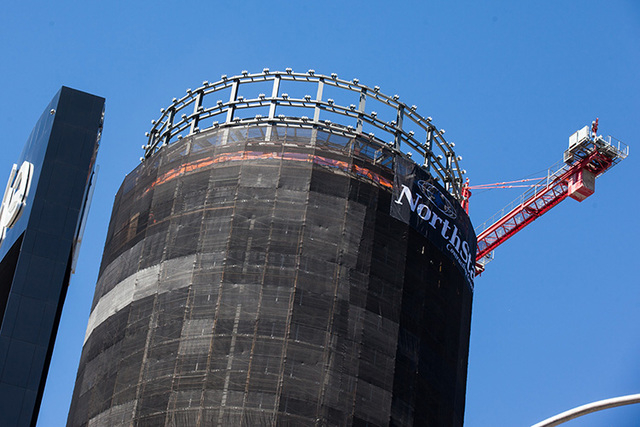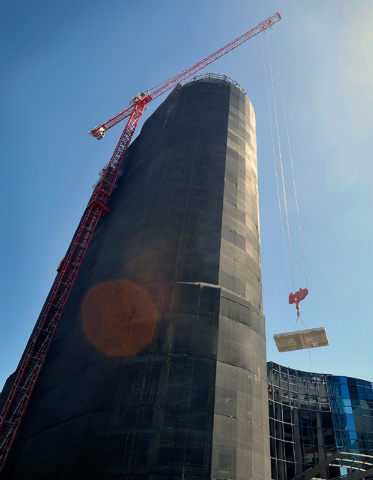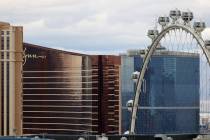Deconstructing the Harmon Hotel mess


On paper, it appeared MGM Resorts International lost the construction defect lawsuit over CityCenter’s mistake-riddled Harmon Hotel.
The reality is the casino giant won the war by making this 4-year-old legal mess go away.
As 2014 draws to a close, MGM Resorts is on an upswing.
Analysts view the company as an investment opportunity, primarily because of its new properties under development on the East Coast and in Macau. MGM Resorts has a solid foothold on the resurgent Strip through its 10 properties and its nongaming development plans, including a 20,000-seat sports arena, the 33-acre Rock in Rio festival grounds and The Park retail and dining district.
MGM Resorts’ balance sheet is strong, with $1.3 billion in cash as of Sept. 30. The company’s $11.7 billion in long-term debt is manageable — compared with that of rival Caesars Entertainment Corp. The bulk of MGM Resorts’ debt doesn’t come due for another five years.
So paying $173 million to end the Harmon mess was a wise investment.
The trial over $400 million in damage claims in District Court in Clark County was expected to drag on for more than a year. Numerous MGM executives and officials — including CEO Jim Murren — were expected to be called as witnesses.
The trial would have drawn attention to financial problems and issues the company had long had in its rearview mirror.
Simply put, MGM Resorts had much to gain by ending this skirmish with CityCenter general contractor Tutor Perini Corp.
Nondisclosure agreements preclude MGM and Perini from commenting publicly on the settlement, which was announced just before opening arguments were to start Dec. 16.
But as publicly traded companies, the casino operator and the contractor were required to disclose the settlement’s financial terms to investors.
MGM Resorts said it would pay $173 million to resolve the lawsuit, with $20 million going to CityCenter and $153 million to Perini. The contractor said it would receive “total net settlement proceeds” of $189.5 million on its lien claims. Perini also had to pay CityCenter $11 million.
You decide who won.
The bottom line is that MGM Resorts didn’t have to dig too deep into its wallet. In its SEC filing, the company said $72 million would come from CityCenter condominium sales proceeds held in escrow. The other $101 million came from company accounts.
Investors were initially sour on the settlement. Shares of MGM Resorts fell 5 percent on the day of the announcement. Analysts sought to alleviate concerns.
Morgan Stanley gaming analyst Thomas Allen said, “MGM’s significant underperformance today was unwarranted. The settlement … should not be viewed as a major incremental negative for the stock.”
Duetsche Bank gaming analyst Carlo Santarelli pointed out MGM owns 50 percent of CityCenter and could receive $88 million of the development’s proceeds from the settlement.
“The total cash impact to MGM is less than about $13 million,” Santarelli told investors.
MGM also has new revenue sources.
In September, New Jersey gaming regulators restored MGM’s license for a half-ownership in Atlantic City’s Borgata. The company collected $83 million — its share of Borgata’s profits — accumulated in escrow since the company surrendered its license in 2010.
MGM is also proceeding on its East Coast developments, including the $1.2 billion MGM National Harbor in Maryland near Washington, D.C.
CityCenter, meanwhile, has become profitable.
The Harmon litigation was like a hangover that wouldn’t fade.
The hostilities with Perini began in 2008 when construction on the Harmon — a planned 47-story hotel and condominium tower — was halted at 26 floors. Inspectors found defects in the building’s steel reinforcement. The materials used wouldn’t support more floors.
CityCenter opened in December 2009 at a cost of $8.5 billion.
The Harmon was the only piece of the 67-acre complex never completed. The building was just a shell behind a glass facade often wrapped with advertisements for CityCenter attractions.
Meanwhile, MGM blamed Perini for the Harmon’s failure and refused to pay construction costs. Perini sued and said MGM Resorts’ designers were at fault. Other litigants included steel companies and buyers of condominiums that were never built.
Perini claimed the tower could be fixed. MGM said the Harmon was irreparable and needed to be demolished.
A structural engineer hired by MGM Resorts determined the building was unsafe and could topple in a 7.7-magnitude earthquake.
Perini gave up trying to save the Harmon this year, but said MGM’s testing had damaged the building beyond repair.
CityCenter is paying for the current Harmon demolition, which could be completed by summer.
If there’s a hero is this mess, it’s Chief District Judge Jennifer Togliatti.
In 2010, then-Nevada Gov. Jim Gibbons tried to unsuccessfully to bring the sides together.
Togliatti succeeded where Gibbons failed.
At the request of trial Judge Elizabeth Gonzalez, Togliatti brokered the settlement through meetings, phone calls and negotiations over 15 months. Two marathon sessions in early December sealed the deal.
Togliatti told the Las Vegas Review-Journal’s Carri Geer Thevenot that the Harmon litigation was “incredibly complicated — both factually and legally.”
In the end, the parties realized a trial would benefit no one.
“What it really took was a willingness to act in good faith and compromise, because I think they were all confident in their legal positions,” Togliatti said.
Even if we don’t know who won.
Howard Stutz’s Inside Gaming column appears Wednesdays and Sundays. He can be reached at hstutz@reviewjournal.com or 702-477-3871. Follow on Twitter: @howardstutz.












